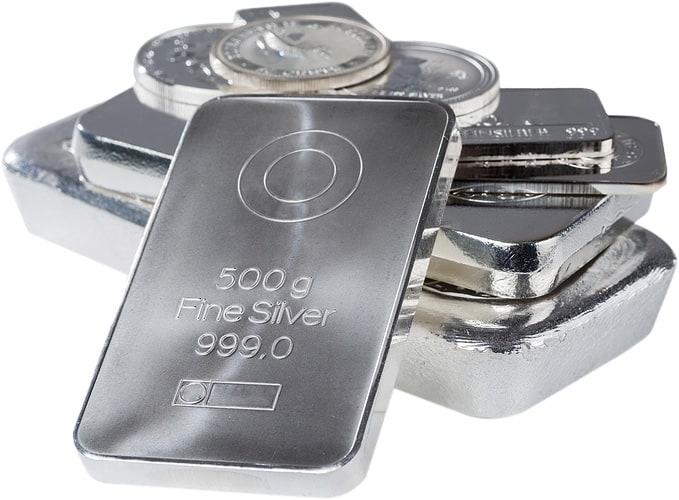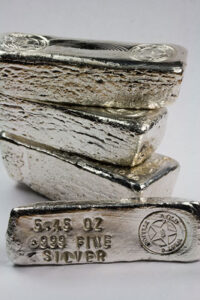 Silver bullion comes in a variety of assets including ingots, bars, and rounds. This dynamic range of options is a common source of confusion among investors looking to diversify with physical silver assets. All of these investment vehicles boast impressive silver purity and inherent value, yet there are some important distinctions that investors should be aware of before making a purchase.
Silver bullion comes in a variety of assets including ingots, bars, and rounds. This dynamic range of options is a common source of confusion among investors looking to diversify with physical silver assets. All of these investment vehicles boast impressive silver purity and inherent value, yet there are some important distinctions that investors should be aware of before making a purchase.
What is a silver ingot?
 A silver ingot refers to the casting of pure silver or a silver alloy into a particular shape that’s more convenient for further processing, storage, or distribution. These forms are created by heating raw silver beyond its melting point, pouring the molten silver into a mold, and cooling it down to take on the desired shape. Usually, a silver ingot is in the form of a bar, block, or slab. The term has pretty much fallen out of usage concerning the precious metals industry, but ingots are common features of manufacturing and industrial production.
A silver ingot refers to the casting of pure silver or a silver alloy into a particular shape that’s more convenient for further processing, storage, or distribution. These forms are created by heating raw silver beyond its melting point, pouring the molten silver into a mold, and cooling it down to take on the desired shape. Usually, a silver ingot is in the form of a bar, block, or slab. The term has pretty much fallen out of usage concerning the precious metals industry, but ingots are common features of manufacturing and industrial production.
These forms are often produced quickly to give manufacturers a more convenient medium through which to handle silver. You can think of silver ingot as a rough draft in the process of creating the final product. Sometimes, these rough drafts are kept in this prototypical stage to be used as silver reserves or currency. In other instances, a silver ingot can be melted down again for further production into a more refined silver bar.
Silver Ingot vs Silver Bar
If you think a silver ingot sounds a lot like a silver bar, you’re not alone. In fact, most people use the terms “ingot” and “bar” interchangeably. It’s understandable as a silver ingot and bar both refer to a block-like shape of relatively pure silver. However, there are some nuanced differences.
Generally, a silver ingot can be thought of as the predecessor to the silver bar. They’re usually more rudimentary in form, rougher in appearance, and more varied in size and shape. On the other hand, silver bars feature more intentional shapes and more purposeful designs. There’s a premium placed on uniformity, aesthetics, and precisions with silver bars.
Furthermore, silver bars follow strict purity and weight standards. These crucial details are emblazoned on the bars along with the mint’s name, a unique serial number, and the mint date This essential information and meticulous uniformity make silver bars a favored investment as they’re easier to trade and evaluate when compared to silver ingots.
What is a silver ingot worth?
The value of a silver ingot is determined by a multitude of factors including its silver purity, weight, and the spot price of silver. You can roughly determine a silver ingot’s market value by multiplying [spot price of silver] x [weight/ounces of silver].
👉 If you are interested in selling silver ingot bars, coins or rounds, you can always contact us for a free appraisal.
What is a silver round?
Silver rounds are coin-like pieces of silver produced by private mints for the sole purpose of investing. They’re usually minted with intricate designs commemorating a notable person, cultural event, or historical period. Because of their investment focus, silver rounds tend to have a high fineness rating between .9990 and .9999.
Unlike their bullion coin counterparts, silver rounds cannot be used as legal tender because they’re not issued by government mints. With high purity ratings, silver rounds primarily derive their value from their silver contents. These assets don’t accrue numismatic value and remain only worth their weight in silver.
Should you invest in a silver ingot, bar, or round?
In the end, the ideal investment asset will depend on your unique objectives, financial parameters, timeline, and personal preferences. These three types of silver assets share many similarities including high purity ratings, ease of storage, and size variety.
Silver ingots and bars come in larger sizes which better accommodate sizeable investments, while silver rounds offer greater investment flexibility given their smaller sizes. Neither a silver ingot, bar, nor round will garner numismatic value, so their evaluations will always be determined by their silver contents.
In reality, most investors will never come across a legitimate silver ingot. These raw casts are usually held by mints for further processing into final silver products or stored as silver reserves by institutional and governmental investors.
Interested in learning more about diversifying your portfolio with silver products?
Grab a FREE copy of our Silver Investment Guide. It covers all you need to understand about protecting your wealth with silver, and other physical metals.



